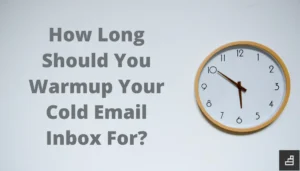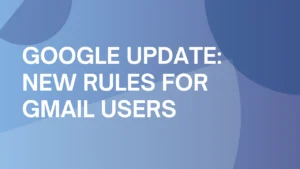
How to warm up an email domain (+ best practices)
Before you start sending large volumes of emails from a new domain, you need to warm it up first. Domain warm-up helps you build trust with email service providers (ESPs), improve your sender reputation, and avoid landing in spam folders.
Domain warm-up is a process of sending emails from a new (or cold) email domain and gradually increasing send volumes in order to establish a positive email reputation.
Here’s a quick overview of the most important steps to warm up your email domain:
- Start small: Send low volumes of emails to highly engaged contacts.
- Gradually increase volume: Scale up your sends over several weeks.
- Authenticate your domain: Set up SPF, DKIM, and DMARC records properly.
- Avoid spammy language: Watch out for trigger words in your subject lines and content.
- Keep your list clean: Verify emails regularly and remove invalid or unengaged addresses.
- Prioritize engagement: Aim for replies, clicks, and forwards — not just opens.
- Monitor your reputation: Use tools like Google Postmaster Tools and Microsoft SNDS.
- Use a warm-up tool: Automate the process and get early feedback on deliverability.
Why is domain warm up important?
The purpose of domain warm-up is to improve your domain reputation and gain ESPs’ trust so all your emails can be delivered right into recipients’ inboxes (and not be blocked by spam filters).
Whenever you start sending emails from a completely new email domain with zero reputation, ISPs (Internet Service Providers) and ESPs can get suspicious about it and prevent your domain from delivering a larger number of messages at once until you “prove” that you are a reliable email sender.
Once ISPs have some historical data about your domain and your email activity, they will allow you to send more messages to a larger audience – or vice versa, throttle your email volumes if you start to have a bad domain reputation.
Domain warmup helps to create a positive email reputation for your new domain by gradually sending a larger and larger number of messages over several weeks until your domain is ready and properly “warmed up”.
| Note: It is important to understand that domain reputation is not the only factor that can impact your email deliverability.ISPs and ESPs also take into consideration the reputation of your IP address, subdomains, or even a specific email address when determining if or how many messages should be delivered to your recipients. |
Understanding Email Service Provider (ESP) expectations
Email Service Providers (like Gmail, Yahoo, Outlook, and others) are cautious by default. When a new domain suddenly starts sending emails, it immediately raises a red flag.
ESPs assume you’re either a spammer or a sender who hasn’t built trust yet, and they’ll limit your deliverability until you prove otherwise.
That’s what warm-up is really about: earning trust over time.
Each ESP has slightly different filters and thresholds, but they all look for similar behavioral signals:
- Consistent sending patterns (no volume spikes)
- Low bounce, complaint, and unsubscribe rates
- Active engagement from recipients – especially replies and clicks
- Proper authentication (SPF, DKIM, DMARC)
They also monitor the quality of your infrastructure and sending domain over time. Some, like Gmail, even track inbox behavior (do users delete your emails without reading them? Do they mark you as important?).
Tip: This is why domain warm-up isn’t one-size-fits-all. A gradual ramp-up tailored to your audience and ESP landscape gives you the best chance of long-term success. To get expert-level help, check out our ESP Warmup tool.
What impacts domain reputation?
A domain’s reputation can be influenced by many factors such as:
- Delete rate – the number of recipients that moved your emails into their trash folder.
- Spam reports – the number of spam complaints that your domain receives.
- Unsubscribe requests – people who unsubscribed from your email list.
- Email content – the quality of your messages, usage of spam words, grammar mistakes, the trustworthiness of links (if included), etc.
- Engagement rate – the number of people who opened, replied to, or forwarded your emails.
- Blacklists – The reputation of a domain address can suffer if it is put on one of the popular email blacklists.
- Bounce rate – the number of emails that were not delivered to recipients’ inboxes.
- And many, many other factors…
It’s important, though, to understand that not all of these components carry the same weight.
For example, if some people unsubscribe from your email list, the domain reputation won’t change that much – on the other hand, having many spam reports can severely damage the reputation of your domain.
Source: snov.io
The role of subdomains in email deliverability
Your main domain isn’t the only thing that builds a reputation; subdomains play a big role too.
Just like your root domain (yourcompany.com), subdomains (marketing.yourcompany.com or billing.yourcompany.com) develop their own reputations with ESPs. That means you can segment different types of email activity across subdomains to better control your deliverability.
Why this matters:
- Risk management: If something goes wrong—say your marketing emails get too many spam complaints—it won’t necessarily impact your transactional emails if they’re sent from a separate subdomain.
- Reputation isolation: Each subdomain’s reputation is tracked separately, allowing you to troubleshoot and optimize each stream of emails independently.
- Warm-up flexibility: You can warm up a subdomain independently from the root domain, especially helpful when launching a new campaign or product.
When to use subdomains:
Some common ways companies use subdomains are as follows, but you may find you need different subdomains:
- Marketing campaigns: Use marketing.yourcompany.com
- Transactional emails: Use billing.yourcompany.com or notifications.yourcompany.com
- Cold outreach: Consider a dedicated subdomain like outreach.yourcompany.com
This kind of setup isn’t just for big businesses, it’s a smart move for anyone sending more than one type of email regularly. Warming and managing subdomains helps protect your main domain and boosts your deliverability across the board.
How to approach domain warm-up: A Daily/Weekly Schedule
Warming up a domain isn’t a one-day task – it’s a gradual, intentional process designed to build trust with ESPs.
Here’s a sample phased approach to guide your warm-up schedule:
| Phase | Who to Send To | Volume | Goal | Tips / Watchpoints |
| Phase 1: Initial Trust Building (Week 1) | Only your most active and engaged contacts | 10–20 emails per day | Generate opens, clicks, and replies | Personalize emails and encourage replies |
| Phase 2: Gradual Expansion (Weeks 2–3) | Broaden to moderately engaged contacts | Double your volume each week (e.g., 20 → 40 → 80) | Maintain strong engagement while scaling | Watch for bounce rate spikes or spam complaints |
| Phase 3: Scaling to Full Volume (Week 4+) | Your full intended audience (avoid risky/inactive emails) | Ramp up to target daily volume | Sustain reputation at normal sending levels | Continuously monitor engagement, sender score, and deliverability |
If you want to save time and remove guesswork, a warm-up tool like Warmup Inbox can automate this process for you. It handles everything from email volume scaling to generating real engagement, pulling messages out of spam, and tracking your sender health.
Email domain warming – best practices
Domain warmup involves a lot of activities that can slowly (but surely) improve your domain reputation over time.
Here are a few practices that you should keep in mind when warming up your email domains:
- Know your sending limits
- Implement email authentication
- Improve IP reputation
- Avoid spammy words
- Provide high-quality content
- Maintain regular conversations
- Clean your email lists
- Switch to a dedicated IP
- Use warm-up tool
1. Know your sending limits
Depending on the number of emails you want to send per day, you may want to look into upgrading your ESP.
We do not recommend sending email blasts from a free Gmail or Outlook account because scammers tend to use these and you will be flagged.
It’s also important to understand that many ESPs equate the “number of emails sent” with the “number of recipients.” In short, trying to circumvent the limits by BCC-ing all of your recipients on a single message won’t work.
Here’s a quick list of some of the most popular ESPs and their sending limits.
| Email Service Provider | Sending Limit (Per Day) |
| Gmail (Free) | 500 |
| Gmail (Google Workspace) | 2000 |
| Outlook (Free) | 300 |
| Microsoft 365/Office 365 | 10000 |
| Zoho (Free) | 50 |
| Zoho (Paid) | 300 |
| Zoho (Custom) | 2500 |
| GoDaddy | 250 |
| RackSpace | 10000 |
| Yahoo! | 500 |
| BlueHost | 150 (per hour) |
| DreamHost | 100 (per hour) |
| Yandex.mail | 500 |
| HostGator | 12000 |
| Amazon SES | 10000 |
| Proton Mail (Free) | 150 |
| Proton Mail (Plus) | 1000 |
| Proton Mail (Professional/Visionary) | unlimited |
| AOL | 500 |
| Mailgun | 300 |
| SendGrid (Free) | 100 |
| SendGrid (Essentials) | Up to 100,000 per month |
| SendGrid (Pro) | Up to 1.5 million per month |
| Sendpost (Starter) | 10,000 per month |
| Sendpost (Growth) | 600,000 per month |
| Sendpost (Scale) | 3 million per month |
2. Implement email authentication
Email authentication can indicate to ISPs that your domain is reliable and can be trusted.
Authentication allows receiving servers to quickly verify your emails and prevent hackers from spoofing your account.
It also shows that you prioritize your customers’ well-being and don’t want them to be flooded with spammy messages.
The email authentication consists of 3 parts (and it’s best to take the time to complete all of them):
- Sender Policy Framework (SPF) – A DNS record that allows you to specify authorized domains that can send messages on your behalf.
- Domain Keys Identified Mail (DKIM) – A DNS record that adds encryption to all of your outgoing emails so the servers can see that your email content hasn’t been tampered with.
- Domain-based Message Authentication, Reporting, and Conformance (DMARC) – A DNS protocol that uses both SPF and DKIM to assist ISPs when validating the authenticity of your emails.
3. Improve IP reputation
Having a positive IP reputation is as equally important as having a good domain one.
If your IP address gets a bad rep, all of your emails will be either blocked or simply end up in the spam folder – and your domain reputation will suffer along the way too.
ISPs are doing everything they can to protect their users from spam and malicious content, so if you have a less-than-stellar IP reputation, your emails might not get delivered to your subscribers.
4. Avoid spammy words
Spam filters are sensitive to the content that your emails contain, especially for risky words that just attract attention and mislead the readers.
Due to this fact, try to avoid words like “FREE”, “75% OFF”, “BUY RIGHT NOW”, etc., since it will just increase the chance that your emails will end up in spam folders.
The same can be applied to click-bait titles or claims in your emails that are promising some prize but in reality leading to something completely different.
Here is a list of spammy words that you should not include in your emails if you want to have a positive IP reputation (collected by Mailjet):
5. Provide high-quality content
Writing a good and relevant email copy does not probably need an explanation – if your email content seems like a scam, recipients won’t click on any of your promotion links (and probably won’t open your messages in the future ever again).
At the end of the day, with scammy content, you will probably get a lot of spam reports – which will hurt your domain warm-up process as well as your domain reputation overall.
Although creating good email copy is a little bit of an art and requires some marketing skills, there are a few ways how you can improve your email content immediately:
- Personalize the message – whether it is the name or the location of the recipient, writing a personalized email will keep the reader engaged and more willing to read your full message.
- Keep the optimal length – depending on the type of your email, you might consider creating a shorter (or longer) version of your content. In cases like sales emails or lead generation, nobody likes to read tons of text (especially if it is just a reminder of some product promotion or discount). On the other hand, newsletters or marketing emails tend to have slightly longer content.
- Make it readable – try to keep sentences short and concise, divided into small paragraphs, and with an easy-to-read font that users can quickly scan.
6. Maintain regular conversations
Creating positive engagement and getting responses is a huge plus for your domain reputation – but that is just half of the work.
When getting answers to your messages, try to keep up the conversations flowing and reply to users who wrote you back.
Having regular conversations is a strong signal for email service providers that your email account is trustworthy – which leads to a quicker warmup of your email domain.
7. Clean your email lists
Regular cleaning of your email lists will help you save your resources as well as keep your open rates and CTRs high (since you will be keeping only email addresses that are used by real people).
Cleaning your email lists can also help you get rid of the users who simply are not interested in your content anymore (and probably won’t read your emails even after 5 or 10 email campaigns).
To get rid of invalid email addresses, spam traps, or soft bounces, you need to use tools like EmailListVerify that can automatically “catch” and delete these types of addresses for you.
Regular checking and cleaning of your email lists can help you to:
- Save money (and time) – with a “healthy” email list, you can be sure that your messages will be delivered to real people and won’t be wasted on error email addresses or bots.
- Protect your domain reputation – every email list can get some invalid email addresses, soft/hard bounces, or spambots from time to time. That’s why regular verification of emails in your list can protect your domain and IP reputation and keep them safe from unwanted email addresses
8. Switch to a dedicated IP
If you’re operating on a shared IP, you may want to consider transferring your information to a dedicated IP to have more control over your reputation.
Shared IP and its reputation can be negatively impacted by other people who are using it as well – even if you try your best to properly warm up the IP address, the IP reputation could be easily damaged by spammers or scammers who would use the given IP for their malicious email activities.
Switching to a dedicated IP address will help you to solve this issue and give you full control over its reputation (+ domain reputation as well).
9. Use warm up tool
Warming up a new email domain is a pretty straightforward process but also very time-consuming: you have to prepare engaging content, keep up with conversations, and continuously send more and more emails over a long period of time.
That is why it is always a good idea to use tools that are capable of warming up inboxes for you, such as our Warmup Inbox tool.
Warmup Inbox is an easy and straightforward tool – it sends out emails on your behalf, gets responses, creates engagement in email threads, etc. within our platform.
It contains hundreds of other email accounts that automatically communicate with each other.
Once your email account is synced with Warmup Inbox, there are a number of ways that our tool can help automate the process of building up your email reputation:
- Send and receive automatic emails – Warmup Inbox is capable of creating dynamic content that is sent and received within our platform.
- Pull out your emails from the spam folder – if some of your emails end up marked as spam by an ESP, Warmup Inbox will automatically pull those emails out from the spam folder and correct them as important messages (which will automatically improve the reputation of your email account).
- Monitor email blacklists – Warmup Inbox monitors all major email blacklists and constantly checks if any of the synched email accounts are not listed in some of them.
- Track your “health” score – Warmup Inbox tool will give you a clear overview of the sender health of your sender domain – it scores your account on a scale of 0 – 10 based on many factors that influence the email deliverability (e.g.blacklists, security protocols, the quality of your email message, etc.).
Advanced warm-up strategies & troubleshooting
Even a carefully planned domain warm-up can hit roadblocks. No matter if you’re dealing with deliverability dips, poor engagement, or technical hiccups, understanding the root cause and how to respond is key.
Here’s how to tackle the most common issues — and how to bounce back.
High bounce rates
Too many bounced emails tell providers you’re sending to bad addresses. This damages your sender reputation and stalls your warm-up progress.
What to do: Pause sending. Clean your list using a tool like EmailListVerify, and switch to a double opt-in process to ensure future subscribers are real and engaged.
| Issue | Cause | Fix |
| Hard bounces | Invalid or non-existent addresses | Use a list cleaner before sending |
| Soft bounces | Full inboxes or temporary delivery issues | Retry later, remove addresses after repeated failures |
| Spam traps | Purchased or scraped lists | Never buy lists; validate all entries |
Low engagement
Low open or click rates suggest your emails aren’t interesting or relevant and that hurts your reputation.
What to do: Focus on engaged contacts first. Personalize subject lines and content. Send at times your audience is active, and avoid overly salesy language.
| Issue | Cause | Fix |
| Low open rates | Boring or unclear subject lines | Test variations, use personalization |
| Low clicks | Unclear CTAs or weak content | Add value, make CTAs visible and relevant |
| Silent readers | No replies or forwards | Ask questions, encourage feedback |
Spam complaints
Too many “Report Spam” clicks can tank your deliverability — fast.
What to do: Make unsubscribing simple and obvious. Only send to people who’ve clearly opted in. Avoid misleading subject lines or aggressive offers.
| Issue | Cause | Fix |
| Spam reports | Misleading copy or poor targeting | Clean lists, clarify intent, re-permission old users |
| High opt-out rate | Emails feel pushy or too frequent | Set expectations, let users choose frequency |
| Hidden unsubscribe | Small font, buried links | Make the link visible and easy to find |
Throttling
Throttling happens when ESPs slow or stop your email delivery due to sudden spikes in activity.
What to do: Stop sending to large lists. Go back to a smaller, high-engagement segment and ramp up again using a slower, steadier schedule.
| Issue | Cause | Fix |
| Delayed emails | Volume too high for your domain/IP | Reduce volume and spread sends over more time |
| Blocked delivery | ESP sees you as suspicious | Warm up gradually, send to engaged users first |
Blacklist issues
Landing on a blacklist can completely block your messages — even to subscribers who want them.
What to do: Use tools like MXToolbox to check for listings. If you are on one, investigate the cause (bounces, spam traps, etc.), fix the problem, then request removal.
| Issue | Cause | Fix |
| Listed IP/domain | High bounces, spam traps | Clean lists, follow best practices |
| Delivery failures | Blacklist blocks email from ESPs | Monitor regularly and request delisting once the issue is fixed |
| Tip: If you are preparing a wide-scale email campaign, you can book a 30-minute free consultation. |



